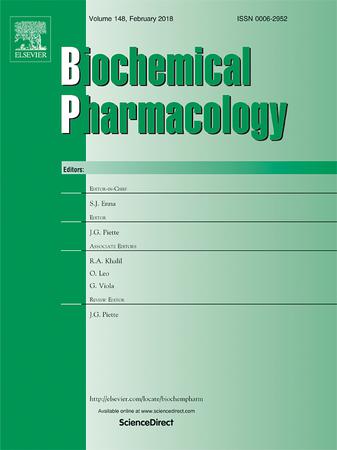Exploring the anticancer potential of ergosterol and ergosta-5,22,25-triene-3-ol against colorectal cancer: Insights from experimental models and molecular mechanisms
IF 5.6
2区 医学
Q1 PHARMACOLOGY & PHARMACY
引用次数: 0
Abstract
Colorectal cancer (CRC) is the third most frequently diagnosed cancer and second leading cause of cancer associated mortality globally. Aberrant cholesterol metabolism due to altered expression and activity of Liver X Receptors (LXRs) contribute significantly to the development of CRC. Previously, we had identified ergosterol (ERG) and ergosta-5,22,25-triene-3-ol (ERG2) as LXR agonists with selective cytotoxicity towards colon cancer cells. The present study was designed to further understand their anticancer potential and mechanism of action. In HCT116 cell, both ERG and ERG2 increased the cell population in the late stage apoptosis via increasing the expression of Bax, CD95, and decreasing the expression of Bcl-2. They also suppressed cell survival and proliferation by reducing the protein expression of cyclin D1, Ras, and MEK1/2, and inhibiting the phosphorylation of PI3K. Erg and Erg2 also suppressed cell invasion and metastasis, which was evident from the decrease in cell migration of HCT116, SW620 cells and protein expression of MMP2 and MMP9. The present study also assessed the chemopreventive potential of ergosterol by using the DMH + DSS induced experimental model of CRC. In line with the findings of the in vitro experiments, ergosterol administration significantly reduced tumor burden, volume, and Ki-67 expression in DMH + DSS + ERG group animals, along with a marked decrease in cancer-like features in the colonic mucosa. It also induced apoptosis and inhibited β-catenin and PI3K/Akt signaling, while upregulating cholesterol efflux genes. Taken together, the findings of the current study are suggestive of the immense anticancer potential of ergosterol mediated through its pleiotropic mode of action.

探索麦角甾醇和麦角糖-5,22,25-三烯-3-醇对结直肠癌的抗癌潜力:来自实验模型和分子机制的见解。
结直肠癌(CRC)是全球第三大最常诊断的癌症,也是癌症相关死亡的第二大原因。肝脏 X 受体(LXRs)表达和活性改变导致的胆固醇代谢异常对结直肠癌的发展有重要影响。此前,我们已经确定麦角甾醇(Erg)和麦角-5,22,25-三烯-3-醇(Erg2)作为LXR激动剂,对结肠癌细胞具有选择性细胞毒性。本研究旨在进一步了解其抗癌潜力和作用机制。在HCT116细胞中,Erg和Erg2通过增加Bax、CD95的表达,降低Bcl-2的表达,增加了晚期凋亡的细胞数量。它们还通过降低cyclin D1、Ras和MEK1/2的蛋白表达以及抑制PI3K的磷酸化来抑制细胞存活和增殖。Erg和Erg2还能抑制细胞的侵袭和转移,这可以从HCT116、SW620细胞的细胞迁移以及MMP2和MMP9蛋白表达的减少中看出。本研究还通过DMH + DSS诱导的结直肠癌实验模型,评估了麦角甾醇的化学预防潜力。与体外实验结果一致,麦角甾醇显著降低DMH + DSS + ERG组动物的肿瘤负荷、体积和Ki-67表达,并显著降低结肠粘膜的癌样特征。它还能诱导细胞凋亡,抑制β-catenin和PI3K/Akt信号,同时上调胆固醇外排基因。综上所述,目前的研究结果表明麦角甾醇通过其多效性作用模式具有巨大的抗癌潜力。
本文章由计算机程序翻译,如有差异,请以英文原文为准。
求助全文
约1分钟内获得全文
求助全文
来源期刊

Biochemical pharmacology
医学-药学
CiteScore
10.30
自引率
1.70%
发文量
420
审稿时长
17 days
期刊介绍:
Biochemical Pharmacology publishes original research findings, Commentaries and review articles related to the elucidation of cellular and tissue function(s) at the biochemical and molecular levels, the modification of cellular phenotype(s) by genetic, transcriptional/translational or drug/compound-induced modifications, as well as the pharmacodynamics and pharmacokinetics of xenobiotics and drugs, the latter including both small molecules and biologics.
The journal''s target audience includes scientists engaged in the identification and study of the mechanisms of action of xenobiotics, biologics and drugs and in the drug discovery and development process.
All areas of cellular biology and cellular, tissue/organ and whole animal pharmacology fall within the scope of the journal. Drug classes covered include anti-infectives, anti-inflammatory agents, chemotherapeutics, cardiovascular, endocrinological, immunological, metabolic, neurological and psychiatric drugs, as well as research on drug metabolism and kinetics. While medicinal chemistry is a topic of complimentary interest, manuscripts in this area must contain sufficient biological data to characterize pharmacologically the compounds reported. Submissions describing work focused predominately on chemical synthesis and molecular modeling will not be considered for review.
While particular emphasis is placed on reporting the results of molecular and biochemical studies, research involving the use of tissue and animal models of human pathophysiology and toxicology is of interest to the extent that it helps define drug mechanisms of action, safety and efficacy.
 求助内容:
求助内容: 应助结果提醒方式:
应助结果提醒方式:


